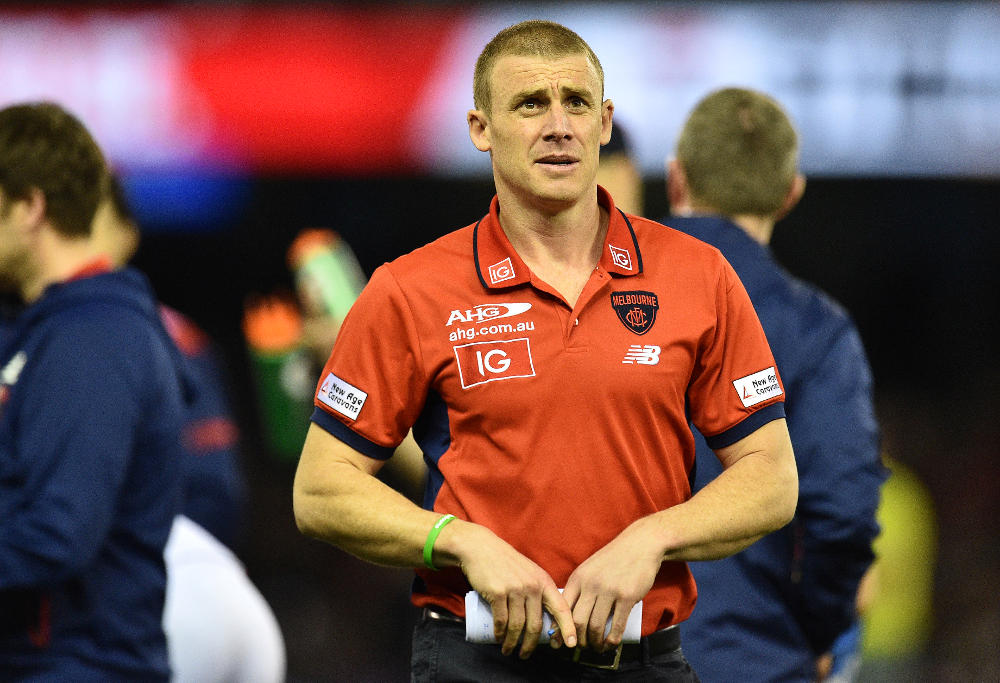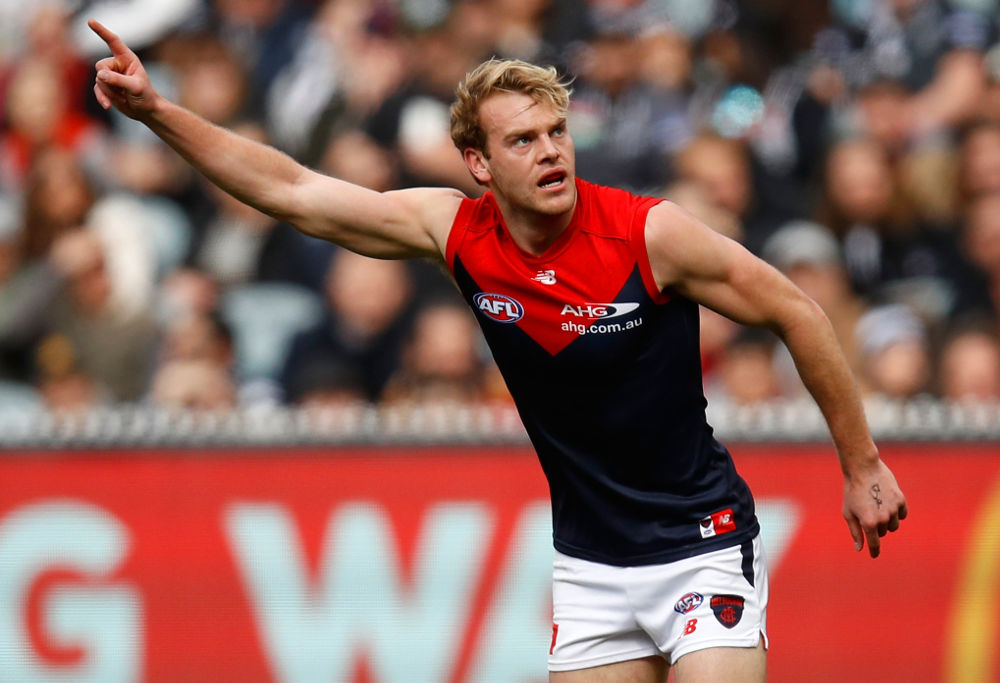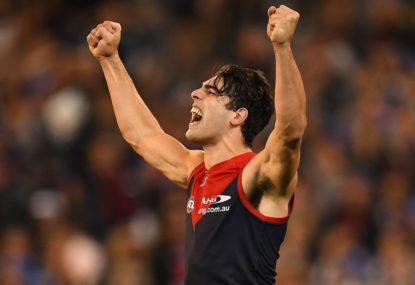The demons have been vanquished. It is time for Melbourne to rise from its ashes and wreak havoc on the competition.
Shoulda, coulda, woulda is not good enough anymore. The Melbourne Demons have the makings of a multi-year finalist and premiership contender, and can no longer abide the rebuild status which they have carried for half a decade.
Paul Roos is long gone, as are all but the last vestiges of the playing group that came before him.
A finish on the playoff bubble – six points out of eighth spot, as it were, and I mean a straight kick, not premiership points – was a fitting way for a season full of false starts to end.
Melbourne played some of the most scintillating football of 2017, combining a hard edge with a sharp outside game that allowed the team to control pace.
The club recorded a net margin of -5.9 points per game against the top eight (ranked seventh), beating Adelaide, Port Adelaide, Essendon and West Coast throughout the year. But they were unable to put away the rest, putting up 11.8 points of margin per game against the bottom ten, and losing to Fremantle, North Melbourne (twice) and Collingwood along the way. Last year’s top four had net margins of 25.9 per game on average against the also-rans.
The Dees lay waste to one of their bogey sides in St Kilda – whom they had not beaten since an elimination final in 2006 – but did not overcome the Roos. Melbourne has not beaten North Melbourne since they were known as geography-less Kangaroos in Round 20, 2006. Shoulda, coulda, woulda.
This year is the year of shall, can and will. Melbourne’s list is in pristine condition, the scars of the tanking years now faded and the team looking built for the flexibility demanded by today’s league. If coach Simon Goodwin can harness this, and eliminate the foibles of 2017, we have this year’s most likely finals leaper on our hands.

Simon Goodwin (AAP Image/Julian Smith)
The circle is complete
Last year saw Melbourne complete its acquisition of the top-end talent sought from the 2014 draft. According to reports, the Dees’ list management team was keen on key defender Jake Lever in his draft year, but chose to cluster Christian Petracca and Angus Brayshaw with the team’s pair of top-five picks.
That view may have been coloured by the means Melbourne came into that second pick (pick three). It was the pick conveyed as compensation for the loss of James Frawley, a then-25-year-old key defender who’d enhanced his reputation during the club’s lean years. Lever represented a fresh start at the position – and one with the upside every club is chasing when picking a big man at the top of the draft.
Petracca and Brayshaw have turned out to be stellar picks in what looms as a top-heavy draft, Brayshaw’s concussion issues notwithstanding. And by trading for Lever, the Dees have their set. When all is said and done, the club is likely to be able to claim to have picked up the three of the best four players in the draft.
The club paid a pretty penny to extract Lever, but when coupled with the gift of free agency compensation, Melbourne has ultimately used three first round picks to assemble its young star trio.
The Lever transaction was the catalyst for Jack Watts’ move to Port Adelaide. Trading Watts had been on the cards for some time, but the timing was a surprise. For all his failings – which were no doubt exaggerated – Watts was a capable second tall forward who could push up the ground and play chess with the best of them.
Lever’s arrival meant the Dees were one tall too heavy. The team couldn’t play all of he, Watts, Tom McDonald, Oscar McDonald, Sam Frost, Jesse Hogan and Max Gawn. Prospective key forward Sam Weideman is waiting in the wings, and Cam Pederson is always available to pinch hit any of the attacking key positions. Watts lost his spot for structural reasons, not because he’s a dud.

Jack Watts (Photo by Michael Willson/AFL Media/Getty Images)
The cascade will likely result in Tom McDonald reprising his role as superhero full-forward from the middle of last year, pushing Hogan up to centre half forward. If there’s a desire for a third tall, they can bring Weideman or Pederson in for stretches, but the two-prong look should be the go-to at the start of the season. We will know in about two weeks.
It brings a lot of change at the bookends, but Melbourne could use it. The Dees scored on just 44 per cent of their inside 50 entries last season, good for 16th in the league. In losses, their scoring clip drops all the way to 40.6 per cent, good for second last. The club generated just under 24 scoring shots per 50 minutes of possession, ranked 13th.
Like a lot of teams, the Dees have been caught on the hop by the league’s forward pressure meta-game. Advanced stats would likely show they don’t score a ton from forward 50 stoppages, and struggle to both create and capitalise on fast break opportunities.
And for much of the last season, Melbourne were tentative with ball in hand. Indeed, at the one third mark of last season, they were taking a truly staggering 113 uncontested marks per game in wins – by the end of the year that had dropped to 84.
They led the league for disposals per minute of possession with 7.9, yet took just 74 field marks per game (ranked 14th) – suggesting lots of sideways movement and indirect play. The club will have spent a lot of time addressing this in the off season.
The steamroller
The interesting feature of the club’s game is their penchant for starting players off the back of the centre square, instead of the wings, at centre bounces.
Most clubs now have this in their arsenal, but the Dees were the first club to roll it out as a standard look. That is all about pace and scoring quickly.
We saw it come to the fore in their first game of 2017, when the Dees put on 64 points to 15 against St Kilda in the second and third quarters of the game. Gawn’s ruck dominance combined with the straight line pace of Melbourne’s second tier of midfielders and half backs to force the ball inside 50 over and over again from the middle of the ground.

AAP Image/Julian Smith
(When other teams started doing this, the league as a collective figured out making body contact with the runners was all it took to snuff it out – as a regular play at least.)
In Round 8, against the Adelaide Crows, the Dees surged from a ten-point halftime deficit to a 27-point three-quarter-time lead, with pacey, direct play. There were plenty of examples of short bursts of high scoring throughout the rest of the year.
The point is: it can be done, and Melbourne can do it with the personnel at their disposal.
That is a signal we should heed: while the Dees can play the touch game, that won’t be the way they win this year. That will centre on their emerging core midfield, chock full of ground-ball machines with long kicks and a risk appetite that would make a Bitcoin investor blush.
Melbourne’s strength when the ball hits the deck is clear. They recorded an adjusted contested possession differential of +7.5 per game in 2017, second in the league to the genetically modified super footballers at Greater Western Sydney.
In wins, that tally pumped up to 11.5 per game, not quite at the stratospheric highs of the new kids (+16.6 per game) but a handy differential indeed.
Winning the ball in these situations is vital, because every contested groundball is an opportunity to get to work moving the ball into a scoring position – logic dictates that doing this more than your opponent is a good thing.
It is a little puzzling that the Dees were better without Gawn in the line up than with him. Melbourne’s adjusted contested possession differential was +12.3 per game when Gawn was out with his hamstring injury, and +5.1 with him. Similarly, the Dees had a clearance differential of +3.3 per game without Gawn, and -1.6 with him.
Cam Pederson was the lead ruckman in those games, suggesting mobility at the position might be more complementary to the Dees’ game style. It’s something for Goodwin and his crew to consider, particularly given the change in key position spots could afford the opportunity to play Pederson as a forward that pinches in the middle for stretches.
[latest_videos_strip category=”afl” name=”AFL”]
The pool runs deep
Melbourne do this with a fanatical attack on the ball by a core group of gritty inside midfielders. Jack Viney is the avatar, but Clayton Oliver is putting up an early career case to be the ‘see ball, get ball’ king of the league.
Brayshaw has proven himself a handy ball winner when he’s on the park, and the indefatigable, sneakily-classy Nathan Jones continues to fly under the radar of every mainstream football pundit in the land. Jordan Lewis chipped in with 26 touches a game last season as the ideal sixth man at stoppages.
Petracca’s year looms as one of transition into that attacking midfielder role – the one Robbie Gray, Dane Zorko, Dustin Martin and Patrick Dangerfield (when he’s not running point) have almost created for themselves over the past three or four seasons. Petracca’s reputation among the football fraternity suffers a bit because of his relatively meagre possession totals; we should have learnt by now that 20 incisive moves can change a game. Speaking of Bitcoin, a declaration: I own half the market capitalisation of Petracca Enterprises.
The Dees have depth, too, albeit the club doesn’t appear to have settled on its first choice set of reserves and link up bodies. On the half back line the team has an All Australian (Michael Hibberd), a future All Australian (Jayden Hunt) and a wily veteran who directs the play (Bernie Vince).
Vince’s play dropped off as last year progressed, but given the likely changes in the key position spot, he’ll start the year. Neville Jetta, he of formerly Most Underrated Player in the league status, is now properly rated as the best small defender in the game, a position few clubs utilise today.
Like last season, Melbourne represents a tantalising set of players with interesting skills and complementary demographics. They have a league-high 19 players all in the 21-t0-24-year-old bracket, including the 2014 draft class trio. Up to a dozen of these guys are in the best 22 or very close.
The query remains whether coach Goodwin and his crew can muster the undeniable talent available, and build a gameplan that sustains the Dees for the full year.
Last year bought a set of challenges by way of injury and absence (through self-inflicted suspension). This year, it would appear Jack Viney – a very important player – is the only significant concern.
Every team is intriguing heading into the preseason competition, but I suspect Melbourne will be doubly so this year.
Melbourne’s fixture difficulty ramps up a smidge in 2018 versus 2017. Ultimately, the Dees faced just one top-eight double-up last year (Adelaide, whom they split the ledger with), this year there will be at least two (the Crows and Cats), and up to four depending on your view of the Western Bulldogs and St Kilda.
But if the Dees deliver on the flashes of last year, it won’t matter too much. Melbourne’s list of excuses for missing the finals is running very short; expect them to burn it themselves in 2018.
































































































